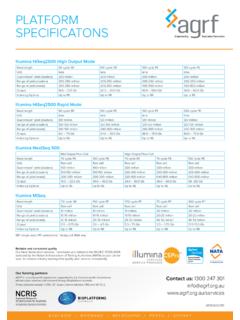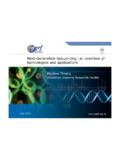Transcription of Sanger Sequencing: Sample Preparation Guide - …
1 Sanger sequencing : Sample Preparation Guide Use this as a Guide to prepare your samples for Sanger sequencing at AGRF. CONTENTS. 1 Overview .. 2. Capillary Separation (CS) or electrophoretic separation only: .. 2. Unpurified BDT reaction (CS+): .. 2. Purified DNA (PD): .. 2. Unpurified PCR product (PD+): .. 3. 2 Sanger Routine sequencing Service Process: .. 3. 3 Three Simple Steps to using AGRF Sanger sequencing Service .. 4. 4 References .. 4. 5 DNA Sample Preparation .. 4. Template Quality: .. 4. Template Quantity: .. 5. Primer Quality and Quantity:.. 5. DNA labelling Preparation for clients using the CS/CS+ service: .. 5. DNA Sample Preparation for clients using the PD service: .. 6. PCR Sample Preparation for clients using the PD+ service: .. 7. 6 Submission formats .. 7. Submitting Plates: .. 7. Preferred Plate Type: .. 7. Preferred Tube Type: .. 8. Sample Labelling: .. 8. Sample Presentation .. 8. Primer submission for PD+ Service: .. 8. 7 Appendix: .. 9. Protocol 1: Magnesium sulphate clean-up protocol.
2 9. Protocol 2: Ethanol/EDTA Precipitation Clean-up Protocol as per the AB. sequencing Guide .. 10. Protocol 3: Ethanol/EDTA/Sodium Acetate Precipitation Clean-up Protocol as per the AB sequencing Guide .. 12. Page 1 of 13. Sanger sequencing Sample Submission Guide (GSEQDOC00166) Approved By: Ken McGrath Release Date: 11/12/2014. 1 Overview The Australian Genome Research Facility (AGRF) is accredited to ISO/IEC 17025:2005 in the field of Biological Testing by the National Association of Testing Authorities (NATA). (Accreditation Number: 14332). AGRF offers high throughput Sanger sequencing using Applied Biosystems 3730 and 3730xl capillary sequencers. These automated platforms use Big Dye Terminator (BDT) chemistry version (Applied Biosystems) under standardised cycling PCR conditions. Sequence data is provided as: *.ab1: The raw chromatogram trace file *.seq: A text file of the sequence, as generated by the sequencing instruments *.fa: A quality trimmed FASTA formatted text file *.
3 Bn: A BLAST file (GenBank) of the quality trimmed FASTA file Additionally, one extra file per batch is generated. This is your batch summary report, which outlines the quality scores and signal intensities for each Sample submitted (further information in Section 9). The flowchart on the following page outlines the process and data outputs (for more information on these file types, see section 9 of this documents). Four sequencing services are routinely offered: Capillary Separation (CS) or electrophoretic separation: Client performs the BDT sequencing reaction and removes unlabelled dyes through a reaction clean-up, and the purified labelled DNA is submitted as a dried down pellet for resuspending and loading directly onto the AB 3730xl instrument. Turnaround time is 1-2 working days after receipt of samples at AGRF (for less than 200 samples ). Unpurified BDT reaction (CS+): Client performs the BDT sequencing reaction and the unpurified labelled reaction is submitted as a 20 l solution, for clean-up and sequencing .
4 Turnaround time is 1-2 working days after receipt of samples at AGRF (for less than 200 samples ). Purified DNA (PD): Purified DNA template (plasmid or PCR product) is pre-mixed with the appropriate primer, and submitted for BDT labelling, purification and sequencing . The turnaround time is between 2 3 working days after receipt of samples at AGRF. (for less than 200 samples ). Page 2 of 13. Sanger sequencing Sample Submission Guide (GSEQDOC00166) Approved By: Ken McGrath Release Date: 18/11/2015. Unpurified PCR product (PD+): This service is only suitable for established PCR reactions that consistently give strong, clear PCR amplicons of equal consistency between samples . Please be aware that no Sample normalisation is provided as part of this service. The PD+ service is designed for users requiring high-volume purification and sequencing of PCR amplicons PCR Amplicon is submitted for purification and sequencing by AGRF. The turnaround time is between 4 and 7 working days after receipt of samples at AGRF.
5 (for less than 400 samples ). Please submit in plate format where possible (for submissions of >10 samples ). 2 Sanger Routine sequencing Service Process: Page 3 of 13. Sanger sequencing Sample Submission Guide (GSEQDOC00166) Approved By: Ken McGrath Release Date: 18/11/2015. 3 Three Simple Steps to using AGRF Sanger sequencing Service 1. Complete your details via the client login on the AGRF website ( ). Your user name and password will be automatically generated and emailed to you 2. Log in to submit your Sample information online 3. Print off your submission recept and send it along with your samples to AGRF. You will receive an email when your samples have been received at AGRF, and again when your sequencing data is available for download from the secure FTP site. 4 References AGRF: AGRF BDT Order form: Thermo Fisher: AB sequencing Chemistry Guide : AB Basecaller Software Frequently Asked Questions document: NATA: 5 DNA Sample Preparation The two most important factors in Sanger sequencing are the quality and quantity of both the DNA template and primer.
6 Template Quality: Automated sequencing on the AB3730 platforms can be affected by the quality of DNA in the reaction. The AB3730 is much more sensitive to many contaminants compared to gel based systems (AB377) and older capillary systems (AB3700). Contaminants may include: RNA. Proteins, Carbohydrates and Lipids Ethanol Buffer salts Elution Buffers ( Qiagen EB buffer). Purification column resins ExoSAP residual chemistry Templates should only be resuspended and submitted in water. To ensure good DNA. quality, templates should be analysed by both: a. Agarose gel electrophoresis using a known mass standard where a visible band should be present on the gel at the expected quantitated level. b. Spectrophotometer to ensure OD260/OD280 range is between and OD260/OD280 < may indicate protein contamination OD260/OD280 > may indicate RNA contamination Page 4 of 13. Sanger sequencing Sample Submission Guide (GSEQDOC00166) Approved By: Ken McGrath Release Date: 18/11/2015. Template Quantity: It is very important to know how much DNA template is being used in order to ensure reliable, reproducible results.
7 The quantity of DNA template required is dependent on its size. Table 1 outlines the quantities required by AGRF for samples and primers that are being sent for the PD and CS services. AGRF prefers template DNA to be quantified by gel electrophoresis, as spectrophotometry tends to overestimate the concentration of the template DNA. Primer Quality and Quantity: sequencing primers should be non-degenerate, homologous to the target region, and have a Tm between 55oC and 60oC. Primers that have been defrosted/frozen many times will degrade, resulting in poorer sequencing performance Table 1: Recommended amounts of template and primer for sequencing reactions Recommended Recommended Quantity for CS. Template Quantity for PD. samples (BDT set up samples (in 12 L). in your own lab). PCR Product 100 200 bp 3 - 8 ng 1 - 3 ng PCR Product 200 400 bp 6 - 12 ng 2 - 4 ng PCR Product 400 600 bp 12 - 18 ng 4 - 6 ng PCR Product 600 800 bp 18 - 30 ng 6 - 10 ng PCR Product >800 bp 30 - 75 ng 10 - 25 ng Plasmid, Single-stranded 150 - 300 ng 50 - 100 ng Plasmid, Double-stranded 600 - 1500 ng 200 - 500 ng Primer Quantity 10pmol* pmol (one primer per reaction) ( pmol/ l).
8 *this equates to 1 L of a 10 M stock, or 2uL of a 5 M stock Please note that these template amounts are guides only and optimisation may be needed. DNA labelling Preparation for clients using the CS/CS+ service: Reactions should be prepared according to Table 2. BDT must be completely thawed before use. It is also recommended that BDT be aliquoted into appropriate working volumes and stored frozen until needed to avoid more than 3 freeze / thaw cycles. Page 5 of 13. Sanger sequencing Sample Submission Guide (GSEQDOC00166) Approved By: Ken McGrath Release Date: 18/11/2015. Table 2: Recommended amounts of template for sequencing reaction Half Half Full Full Volume Volume Volume Volume Components Reactions Reactions Reactions Reactions ( ) ( ) * ( ) (1x). Template (see Table 1). Primer ( pmol/ l) L L 14 L 12 L. MilliQ Water (if necessary). BDT L 1 L 4 L 8 L. 5X BDT dilution Buffer L L 2 L - TOTAL ^10 L ^10 L 20 L 20 L. * Preferred reaction set up for AGRF CS sequencing service ^ For CS+, reaction should be diluted to 20uL prior to submission samples should be free of oil as this may affect the quality of the sequencing data.
9 Large DNA. templates and bacterial genomic DNA can be submitted (please refer to AB sequencing Chemistry Guide for protocols regarding these large templates). AGRF accepts samples that have been precipitated in either tubes or plates. These dry sequencing products are stable for 48 hours at room temperature or ten days at 4oC. Cycle sequencing : The cycling conditions are the same as those outlined in Table 3. Table 3: AGRF Cycling Conditions for PD sequencing service Temperature and Time Number of Cycles 96 C for 2 min 1. 96 C for 10 secs 50 C for 5 secs 30. 60 C for 4 mins 4 C Hold Post Reaction Clean-up Considerations: It is critical to remove all unincorporated dye terminators from the cycle sequencing reaction prior to analysis by capillary electrophoresis to prevent basecalling errors. AGRF currently uses a magnetic bead based method for all internal BDT cleanups. Suitable commercial clean up protocols include CentriSep (ABI), DyeEX (Qiagen) and MicroSpin G-50. (Amersham/Pharmacia).
10 Non-commercial clean-up methods may also be used and protocols for these methods are listed in the Appendix. DNA Sample Preparation for clients using the PD service: The template and sequencing primer (one primer per submission) should be pre-mixed in a total volume of 12 L, according to Table 1. As AGRF operates a high throughput facility, all PD samples are run using the same cycling conditions (Table 3). Therefore melting temperatures for primers should match these cycling conditions. If primers are not able to match these conditions, sequencing data quality may be compromised. Page 6 of 13. Sanger sequencing Sample Submission Guide (GSEQDOC00166) Approved By: Ken McGrath Release Date: 18/11/2015. PCR Sample Preparation for clients using the PD+ service: Each Sample submitted for PD+ must be of a consistent size and concentration. AGRF. recommends that a portion of the PCR reaction is visualised using agarose gel electrophoresis against a known mass standard, where clear single bands of a consistent intensity should be visualised on the gel at the expected size range.


